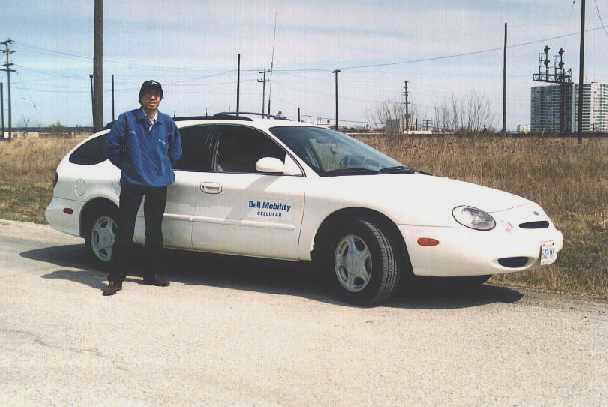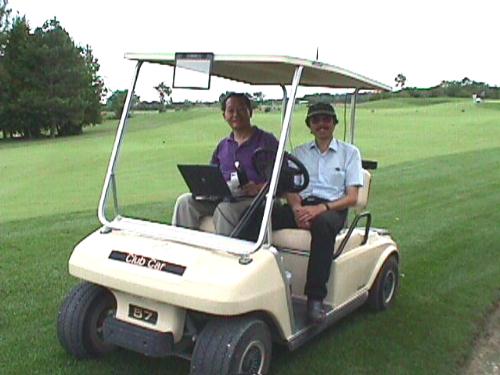Radio coverage/network testing vehicles.
I have a lot of times being approached by friends curious on the antenna farm at my vehicle's roof. Working in a cellular company, I did have some involvement on R.F. coverage testing and have the honor to participate in design and set up of related mobile testing platforms. These test vehicles provide support on top of a conventional service vehicle in terms of:
* Enhanced power plant and filters to support test equipment at multiple voltage.
* Telephone lines for activity co-ordination and data terminals remote log on.
* Antenna arrays and concerned data collecting tools linked with positioning equipment.
My first test car was a GMC Safari. This vehicle stays with me 24 hours a day. It was my major means to move around, my office, warehouse and a first line detection on cellular problems. There was no need to modify the vehicle extensively from a conventional utility truck. The network testing equipment it carried was an RSAT-plus by LCC Inc. RSAT (Real-time system access tool or tester) is a test phone which can decode major cellular service down-link overheads with limited scenery recording support. With a thermal printer or an XT grade laptop, we could capture call status of surrounding sites and have the data used for later analysis. Back in 1990, there was no GPS support on those units yet. We had to rely on manually injected markers inside captured data (to link such collected data with the drive route). This system is primitive but was sufficient to identify repeatable AMPS network problems. There was not much antenna on the roof - only one pair of quarter wavelength roof mount ground planes for each RSAT unit. Sometimes we have a pair of 5/8 wavelength glass mount whip on the wind screen. They were used when we needed to emulate condition of normal mobile users.
.....
As I served later as an R.F. analyst, my test vehicle changed to station wagons. It turned out to be a Ford Taurus. My prime function at the beginning involved antenna quality acceptance plus investigation of AMPS network issues. This vehicle was thus designed to suit multiple sorties and was usually fully packed. The trunk area and the back seats were reserved for shipping of test equipment and spare antennas. One of the usual inventory at that time was the HP 8753C network analyzer (used mostly for antenna and transmission line study). It was packed in a heavy duty strong box. Shipping of this beast would take up most space at the rear portion. There were totally six phone lines programmed within three phones on board. They served call testing, remote computer logging and real time audio quality loop back survey. The main portion of these test gears was stacked on a rack located at the leg space of the rear seat. Their remote heads were mounted mostly around the dash board.
Due to the need to power up 100V AC test equipment, this vehicle is equipped with a 500W DC-AC converter. These extra loads weren't friendly to the original vehicle's design. I ran into alternator issues at the beginning. The problem is finally settled after two alternators are replaced under warranty and an extra 12V battery installed specifically for this power plant.
 ....
....
The RSAT in this vehicle was positioning data supported. This feature allowed us to record drive data with precise linkage to specific spots on a map. The unit installed in my vehicle had GPS navigation only. This was good for most diagnose application except when we have to collect data in downtown area. To have stable 3D lock on GPS, one must be able to see at least 4 satellite. In most cases, it is rare to have more then two satellite right over one's head. As soon as high buildings block out view to the lower portion of the sky, we have trouble to maintain GPS lock. Test vehicles expecting to work under such situation need additional support. The usual choices are employment of dead reckoning technique. Dead reckoning system needs special sensors to be installed on the car body. Some of them are optic sensors that monitor the brake disc and count the rotation of the left and right tires. When a vehicle is making a turn, such difference between the left and right wheels can be compared by a mini processor to generate directional and distance information. Such vector information are then combined with the last known GPS fix (before fading occurred). These systems are usually accompanied with magnetic or gyro compass. The whole idea is to maintain steady feed of location data to the RSAT if the GPS receivers suffers temporary interruption.
This vehicle had a special duty as well. We sometimes received request to hunt down fraud phone or control channel jammers. Fraud phones are illegally cloned phones that create air time usage on a victim customer. Control channel jammers are faulty phones with uncontrolled transmit that blotted out a whole sector from providing service to mobiles. These jobs involved a driver, a radio DF (direction finding) operator and constant contact with the switch staff. That was why this vehicle had so many antennas on the roof. Four quarter wavelength whips on the center of the roof formed a square array. They are connected to the RSAT units under normal situation. When DF activities are to be performed, this square array can be connected to Doppler DF devices. One pair of glass mount antenna on both rear side windows is reserved for spectrum analyzer and computer modem link. Not seen in the above picture is the GPS antenna. That antenna is a two inches diameter disk with a magnetic mount. It was installed on the roof only when data collection is to be performed. Without extra cellular antenna, voice contact between DF operator and the switch staff has to rely on portable phones.
The DF operator sits in the right side of the back seat. The other half of the back seat (folded down) became a desk to mount the spectrum studying equipment. This rear compartment is kept dark with heavily tinted windows. That provides a better environment for the back seat operator to study CRT image even in bright day light and prevents the investigation activities be seen by the 'fox' as we close in our targets.
I am now looking after CDMA network optimization. This job involves frequent use of laptop computers and lengthy drive test operation. I only kept one RSAT unit to investigate conventional AMPS issues. The rest of the spaces are reserved for CDMA diagnose equipment. It is no longer possible to keep all test gears mounted at all times - some of these equipment are too expensive to be left unattended. To get the extra space, one of my colleague has to remove the front passenger's seat before sufficient room is available. Having a station wagon gives me more space to play with. I only removed the arm-rest (between the front seats) and uses the bolts which holds the two front seats to mount a base plate. This base plate acts as a mounting platform for additional stuffs like laptop stand and the control head of my RSAT. A cabinet is built behind the back seats to form a rack for equipment storage. With both back seats restored into upward position, these equipment are hidden and are well protected from impact.
....
Surprisingly, there are less antenna outside this vehicle. That is because CDMA testing usually employs the original phone antenna instead of outdoor antenna. But I still have a pair of roof mount 800MHz Ground plane for the RSAT, a dual band for the UHF/VHF transceivers, one 800MHz glass mount and a dual band (800MHz/1.9GHz) glass mount for PCS data operation.
.....
More space are available at the back seats now but the front seats became a bit cramped. It is a fortune that the data collecting software and the laptops have sound support. Most vital alert messages are presented as voice announcement. This is a much safer way to perform drive test.
click to view how it looks when the laptop is installed.
There are other types of test vehicle in our organization. One of them is the MOS test car. MOS is the short name for MIN opinion scoring. This is a technique to compare reference voice clips sent over the phone circuit in order to generate relative comparison between service of different cellular provider or phone hardware. These vehicles look like normal passengers vehicle from outside. Some of them don't even have external antennas. But close observation of the inside contents revealed racks that mount multiple phones. Those can be phones from different providers or different manufactures. These test are performed constantly to provide a mechanical (nonbiased) judgement of the networks service quality from a customer's point of view.
Occasionally, we have to perform data collection in area not accessible by vehicles. Some alternatives has to be developed to make that possible. We converted our HP cobra unit into a completely portable kit back in 1999. The kit is basically a brief case that holds the scanner, test phone, GPS receiver and battery. Our first application is to perform a CDMA coverage survey inside a famous golf course.
 .....
.....
click to view more detail of the portable PN scanner
That is the first time I enjoyed test driving in a golf cart. I would really loved to get behind such wheels again. Talk to you next time.